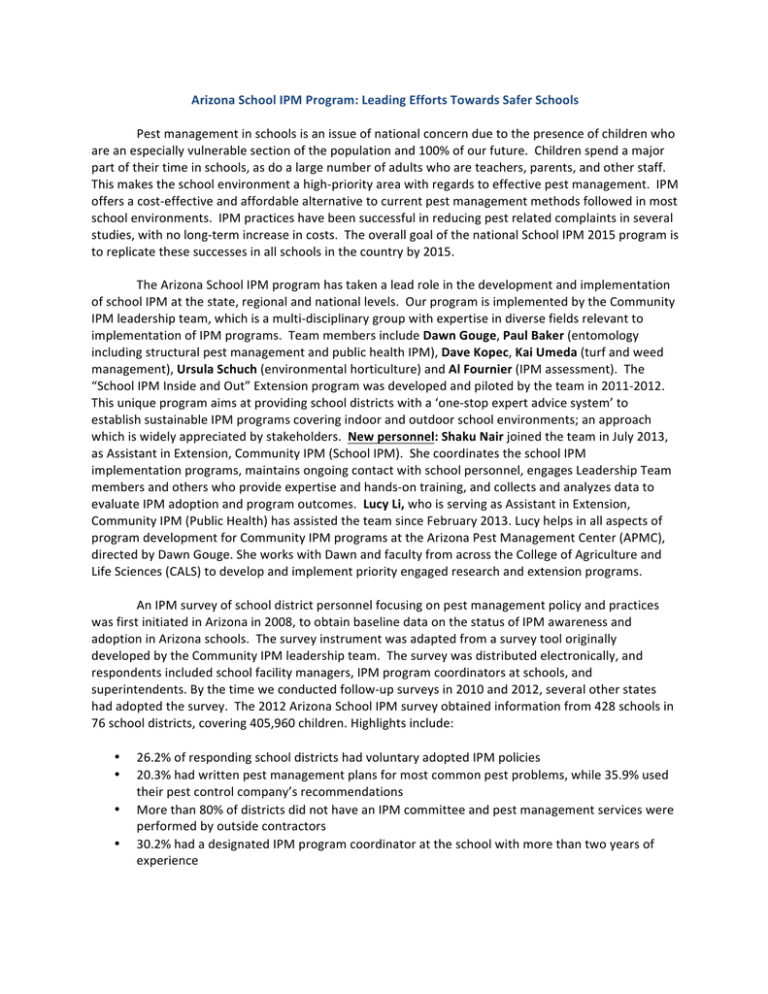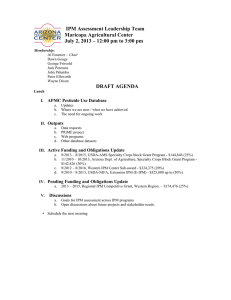Document 10616125
advertisement

Arizona School IPM Program: Leading Efforts Towards Safer Schools Pest management in schools is an issue of national concern due to the presence of children who are an especially vulnerable section of the population and 100% of our future. Children spend a major part of their time in schools, as do a large number of adults who are teachers, parents, and other staff. This makes the school environment a high-­‐priority area with regards to effective pest management. IPM offers a cost-­‐effective and affordable alternative to current pest management methods followed in most school environments. IPM practices have been successful in reducing pest related complaints in several studies, with no long-­‐term increase in costs. The overall goal of the national School IPM 2015 program is to replicate these successes in all schools in the country by 2015. The Arizona School IPM program has taken a lead role in the development and implementation of school IPM at the state, regional and national levels. Our program is implemented by the Community IPM leadership team, which is a multi-­‐disciplinary group with expertise in diverse fields relevant to implementation of IPM programs. Team members include Dawn Gouge, Paul Baker (entomology including structural pest management and public health IPM), Dave Kopec, Kai Umeda (turf and weed management), Ursula Schuch (environmental horticulture) and Al Fournier (IPM assessment). The “School IPM Inside and Out” Extension program was developed and piloted by the team in 2011-­‐2012. This unique program aims at providing school districts with a ‘one-­‐stop expert advice system’ to establish sustainable IPM programs covering indoor and outdoor school environments; an approach which is widely appreciated by stakeholders. New personnel: Shaku Nair joined the team in July 2013, as Assistant in Extension, Community IPM (School IPM). She coordinates the school IPM implementation programs, maintains ongoing contact with school personnel, engages Leadership Team members and others who provide expertise and hands-­‐on training, and collects and analyzes data to evaluate IPM adoption and program outcomes. Lucy Li, who is serving as Assistant in Extension, Community IPM (Public Health) has assisted the team since February 2013. Lucy helps in all aspects of program development for Community IPM programs at the Arizona Pest Management Center (APMC), directed by Dawn Gouge. She works with Dawn and faculty from across the College of Agriculture and Life Sciences (CALS) to develop and implement priority engaged research and extension programs. An IPM survey of school district personnel focusing on pest management policy and practices was first initiated in Arizona in 2008, to obtain baseline data on the status of IPM awareness and adoption in Arizona schools. The survey instrument was adapted from a survey tool originally developed by the Community IPM leadership team. The survey was distributed electronically, and respondents included school facility managers, IPM program coordinators at schools, and superintendents. By the time we conducted follow-­‐up surveys in 2010 and 2012, several other states had adopted the survey. The 2012 Arizona School IPM survey obtained information from 428 schools in 76 school districts, covering 405,960 children. Highlights include: • 26.2% of responding school districts had voluntary adopted IPM policies • 20.3% had written pest management plans for most common pest problems, while 35.9% used their pest control company’s recommendations • More than 80% of districts did not have an IPM committee and pest management services were performed by outside contractors • 30.2% had a designated IPM program coordinator at the school with more than two years of experience • • • • • • 44% reported that schools in their district tracked the number of pest complaints each year, and the average number of complaints documented in a district was 45 66.5% of school districts tracked overall funds spent on pest management each year, and the average amount spent in the last fiscal year was $8,780 63.8% tracked number of pesticide applications in schools or on school grounds, and the average number of applications in a district was 73 Pest or IPM factsheets were used by 36.6% school districts in their IPM programs, 26.8% used pest or IPM posters and 19.5% used school IPM manuals Only 2.4% used IPM curricula or lesson plans for students 64.9% of school districts reported interest in receiving a free monthly newsletter with useful information to reduce pests and pest management costs Our survey provides valuable data that helps us to improve and sustain our program in Arizona. Most importantly, it points towards the need for sustained and dedicated efforts to ensure the popularization and implementation of IPM practices. The insights gained from our program so far will be used to expand and intensify specific areas of the program, as well as extend it to cover more school districts. These efforts will be complemented with intensive outreach campaigns and training workshops that will attract attention from other Arizona schools, resulting in increased adoption of IPM practices. At the regional level, Arizona has led and participates in the Western Region School IPM Implementation and Assessment Work Group, which currently has representatives from Arizona and 12 other western states AK, CA, CO, HI, ID, MT, NM, NV, OR, UT, WA and WY, as well as Hopi and Kashia Band of Pomo Indians. We also have representatives from the U.S. EPA and the IPM Institute of North America. Work group information, including objectives, members, activities, resources and outputs are available at http://cals.arizona.edu/apmc/westernschoolIPM.html. The University of Arizona has played a key role in development and implementation of the national School IPM 2015 program, which is a collaborative effort involving the USDA NIFA Regional IPM Centers, US EPA, many Land-­‐Grant universities, school district personnel, and representatives from private industry, non-­‐governmental organizations and consultants, effectively coordinated through the IPM Institute of North America. Further information about the program can be found at http://www.ipminstitute.org/school_ipm_2015/index.htm. Because School IPM is an important regional and national issue, we will continue leadership of the multi-­‐state collaborations at regional and national levels.


